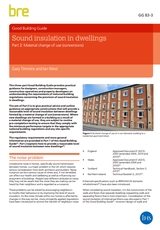Sound insulation in dwellings: Part 3: Material change of use (conversions) (GG 83-3)
BRE (Building Research Establishment) is an independent, research-based consultancy, testing and training organisation, operating in the built environment and associated industries.
Sound insulation in dwellings: Part 3: Material change of use (conversions) (GG 83-3) was written by Gary Timmins and published by BRE on 30 October 2015.
Sound transmission between homes, is a major problem in the UK which requires serious consideration from both architects and builders. Noise nuisance can be a serious cause of stress, and if not remedied it can affect our health and wellbeing as well as influencing our enjoyment of buildings.
Sound insulation in dwellings is a three-part publication which provides practical guidance for designers, construction managers, construction operatives, and property developers about the requirements of the building regulations.
Part 1 sets out the regulatory requirements and general information. Part 2 gives advice on the correct level of sound insulation when constructing new dwellings.
Part 3 offers practical advice and guidance about constructions that provide a reasonable level of sound insulation between dwellings formed by a material change of use. Where new dwellings are formed in a building as a result of a material change of use, they are subject to pre-completion testing to ensure they comply with the building regulations and any site-specific requirements.
The contents of Part 3 of the guide are:
- The noise problem.
- Beginning the process.
- Altering existing walls to form separating walls.
- Altering existing floors to form separating floors.
- Potential conflicts with other regulations and requirements.
- References and further reading.
[edit] Related articles on Designing Buildings Wiki
- Approved Document E.
- BRE articles on Designing Buildings Wiki.
- BRE Buzz articles on Designing Buildings Wiki.
- BRE Buzz.
- Building acoustics.
- Building Research Establishment.
- Noise nuisance.
- Part E compliance.
- Pre-completion sound testing.
- Robust details certification scheme.
- Sound insulation.
- Sound insulation in dwellings: Part 1: An introduction (GG 83-1).
- Sound insulation in dwellings Part 2: New-build (GG 83-2).
- Sound v noise.
- Structure-borne sound.
Featured articles and news
One of the most impressive Victorian architects. Book review.
RTPI leader to become new CIOB Chief Executive Officer
Dr Victoria Hills MRTPI, FICE to take over after Caroline Gumble’s departure.
Social and affordable housing, a long term plan for delivery
The “Delivering a Decade of Renewal for Social and Affordable Housing” strategy sets out future path.
A change to adoptive architecture
Effects of global weather warming on architectural detailing, material choice and human interaction.
The proposed publicly owned and backed subsidiary of Homes England, to facilitate new homes.
How big is the problem and what can we do to mitigate the effects?
Overheating guidance and tools for building designers
A number of cool guides to help with the heat.
The UK's Modern Industrial Strategy: A 10 year plan
Previous consultation criticism, current key elements and general support with some persisting reservations.
Building Safety Regulator reforms
New roles, new staff and a new fast track service pave the way for a single construction regulator.
Architectural Technologist CPDs and Communications
CIAT CPD… and how you can do it!
Cooling centres and cool spaces
Managing extreme heat in cities by directing the public to places for heat stress relief and water sources.
Winter gardens: A brief history and warm variations
Extending the season with glass in different forms and terms.
Restoring Great Yarmouth's Winter Gardens
Transforming one of the least sustainable constructions imaginable.
Construction Skills Mission Board launch sector drive
Newly formed government and industry collaboration set strategy for recruiting an additional 100,000 construction workers a year.
New Architects Code comes into effect in September 2025
ARB Architects Code of Conduct and Practice available with ongoing consultation regarding guidance.
Welsh Skills Body (Medr) launches ambitious plan
The new skills body brings together funding and regulation of tertiary education and research for the devolved nation.
Paul Gandy FCIOB announced as next CIOB President
Former Tilbury Douglas CEO takes helm.
























